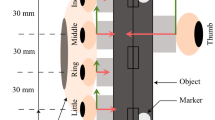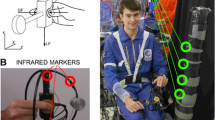Abstract.
Walking while carrying a hand-held object requires the generation of appropriate grip forces to offset the inertial forces produced during locomotion. The present study examined the interaction between grip forces and locomotion-induced inertial forces across the gait cycle. Eight subjects transported a container under three conditions: self-paced transport with and without accuracy constraints and a velocity-constrained condition. The results showed that the trunk and transported container moved in a synchronized, sinusoidal pattern during all conditions. Grip and inertial forces of the transporting hand were highly coupled in an anticipatory fashion, regardless of task demands. The inertial forces were higher and the coupling was greater in the faster, unconstrained condition. However, grip force modulation was observed even when the inertial forces acting on the container were small and applied indirectly to the container through the locomotor effects originating in the legs and trunk. We suggest that continuous grip force adjustment is used as a generalized strategy to maximize efficiency during object transport regardless of the size or origin of the inertial forces.




Similar content being viewed by others
References
Andriacchi TP, Ogle JA, Galante JO (1977) Walking speed as a basis for normal and abnormal gait measurements. J Biomech 10:261–268
Blakemore SJ, Goodbody SJ, Wolpert DM (1998) Predicting the consequences of our own actions: the role of sensorimotor context estimation. J Neurosci 18:7511–7518
Blank R, Breitenbach A, Nitschke M, Heizer W, Letzgus S, Hermsdorfer J (2001) Human development of grip force modulation relating to cyclic movement-induced inertial loads. Exp Brain Res 138:193–199
Cadoret G, Smith AM (1996) Friction, not texture, dictates grip forces used during object manipulation. J Neurophysiol 75:1963–1969
Clayman CB (1989) The American Medical Association Home Medical Encyclopedia, vol 2 I-Z. Reader's Digest Association, New York
Cole KJ, Abbs JH (1988) Grip force adjustments evoked by load force perturbations of a grasped object. J Neurophysiol 60:1513–1522
Eliasson AC, Forssberg H, Ikuta K, Apel I, Westling G, Johansson RS (1995) Development of human precision grip. V. Anticipatory and triggered grip actions during sudden loading. Exp Brain Res 106:425–433
Flanagan JR, Lolley S (2001) The inertial anisotropy of the arm is accurately predicted during movement planning. J Neurosci 21:1361–1369
Flanagan JR, Tresilian JR (1994) Grip-load force coupling: a general control strategy for transporting objects. J Exp Psychol Hum Percept Perform 20:944–957
Flanagan JR, Wing AM (1993) Modulation of grip force with load force during point-to-point arm movements. Exp Brain Res 95:131–143
Flanagan JR, Wing AM (1995) The stability of precision grip forces during cyclic arm movements with a hand-held load. Exp Brain Res 105:455–464
Flanagan JR, Wing AM (1997) The role of internal models in motion planning and control: evidence from grip force adjustments during movements of hand-held loads. J Neurosci 17:1519–1528
Flanagan JR, Tresilian JR, Wing AM (1993) Coupling of grip force and load force during arm movements with grasped objects. Neurosci Lett 152:53–56
Forssberg H, Eliasson AC, Kinoshita H, Johansson RS, Westling G (1991) Development of human precision grip. I: Basic coordination of force. Exp Brain Res 85:451–457
Forssberg H, Eliasson AC, Redon-Zouitenn C, Mercuri E, Dubowitz L (1999) Impaired grip-lift synergy in children with unilateral brain lesions. Brain 122:1157–1168
Gerdes VG, Happee R (1994) The use of internal representation in fast gold-directed movements: a modeling approach. Biol Cybern 70:513–524
Gordon AM (2001) Development of hand motor control. In: Kalverboer AF, Gramsbergen A (eds) Handbook of brain and behaviour in human development. Kluwer Academic, Dordrecht, pp 513–537
Häger-Ross C, Cole KJ, Johansson RS (1996) Grip-force responses to unanticipated object loading: load direction reveals body- and gravity-referenced intrinsic task variables. Exp Brain Res 110:142–150
Hermsdörfer J, Marquardt C, Philipp J, Zierdt A, Nowak D, Glasauer S, Mai N (2000) Moving weightless objects: grip force control during microgravity. Exp Brain Res 132:52–64
Hogan N, Bizzi E, Mussa-Ivaldi FA, Flash T (1987) Controlling multijoint motor behavior. Exerc Sport Sci Rev 15:153–190
Hollerbach JM (1982) Computers, brains and the control of movement. Trends Neurosci 5:189–192
Johansson RS (1998) Sensory input and control of grip. Novartis Found Symp 218:45–59; discussion 59–63
Johansson RS, Westling G (1984) Roles of glabrous skin receptors and sensorimotor memory in automatic control of precision grip when lifting rougher or more slippery objects. Exp Brain Res 56:550–564
Johansson RS, Westling G (1987) Signals in tactile afferents from the fingers eliciting adaptive motor responses during precision grip. Exp Brain Res 66:141–154
Johansson RS, Westling G (1988a) Coordinated isometric muscle commands adequately and erroneously programmed for the weight during lifting task with precision grip. Exp Brain Res 71:59–71
Johansson RS, Westling G (1988b) Programmed and triggered actions to rapid load changes during precision grip. Exp Brain Res 71:72–86
Johansson RS, Häger C, Riso R (1992a) Somatosensory control of precision grip during unpredictable pulling loads. II. Changes in load force rate. Exp Brain Res 89:192–203
Johansson RS, Riso R, Häger C, Bäckström L (1992b) Somatosensory control of precision grip during unpredictable pulling loads. I. Changes in load force amplitude. Exp Brain Res 89:181–191
Jordan MI, Rumelhart DE (1992) Forward models: supervised learning with a distal teacher. Cogn Sci 16:307–354
Kinoshita H, Kawai S, Ikuta K (1995) Contributions and co-ordination of individual fingers in multiple finger prehension. Ergonomics 38:1212–1230
Kinoshita H, Kawai S, Ikuta K, Teraoka T (1996) Individual finger forces acting on a grasped object during shaking actions. Ergonomics 39:243–256
Kinoshita H, Bäckström L, Flanagan JR, Johansson RS (1997) Tangential torque effects on the control of grip forces when holding objects with a precision grip. J Neurophysiol 78:1619–1630
Macefield VG, Johansson RS (1996) Control of grip force during restraint of an object held between finger and thumb: responses of muscle and joint afferents from the digits. Exp Brain Res 108:172–184
Macefield VG, Häger-Ross C, Johansson RS (1996) Control of grip force during restraint of an object held between finger and thumb: responses of cutaneous afferents from the digits. Exp Brain Res 108:155–171
Murray MP, Drought AB, Kory RC (1964) Walking patterns of normal men. J Bone Joint Surg 46A:335–360
Murray MP, Kory RC, Sepic SB (1970) Walking patterns of normal women. Arch Phys Med Rehabil 51:637–650
Nowak DA, Hermsdörfer J, Glasauer S, Philipp J, Meyer L, Mai N (2001a) The effects of digital anaesthesia on predictive grip force adjustments during vertical movements of a grasped object. Eur J Neurosci 14:756–762
Nowak DA, Hermsdörfer J, Philipp J, Marquardt C, Glasauer S, Mai N (2001b) Effects of changing gravity on anticipatory grip force control during point-to-point movements of a hand-held object. Motor Control 5:231–253
Nowak DA, Glasauer S, Meyer L, Mait N, Hermsdorfer J (2002) The role of cutaneous feedback for anticipatory grip force adjustments during object movements and externally imposed variation of the direction of gravity. Somatosens Mot Res 19:49–60
Reilmann R, Gordon AM, Henningsen H (2001) Initiation and development of fingertip forces during whole-hand grasping. Exp Brain Res 140:443–452
Salimi A, Hollander I, Frazier W, Gordon AM (2000) Specificity of internal representations underlying grasping. J Neurophysiol 84:2390–2397
Saunders JB de CM, Inman VT, Eberhart HD (1953) The major determinants in normal and pathological gait. J Bone Joint Surg 35A: 543–558
Schwartz RP, Heath AL, Morgan DW, Towns RC (1964) A quantitative analysis of recorded variables in the walking pattern of "normal" adults. J Bone Joint Surg 46A:324–334
Serrien DJ, Wiesendanger M (2001) Regulation of grasping forces during bimanual in-phase and anti-phase coordination. Neuropsychologia 39:1379–1384
Serrien DJ, Kaluzny P, Wicki U, Wiesendanger M (1999) Grip force adjustments induced by predictable load perturbations during a manipulative task. Exp Brain Res 124:100–106
Stein RB, Oguztoreli MN (1976) Tremor and other oscillations in neuromuscular systems. Biol Cybern 22:147–157
Thorstensson A, Nilsson J, Carlson H, Zomlefer MR (1984) Trunk movements in human locomotion. Acta Physiol Scand 121:9–22
Turrell YN, Li FX, Wing AM (1999) Grip force dynamics in the approach to a collision. Exp Brain Res 128:86–91
Waters RL, Morris J, Perry J (1973) Translational motion of the head and trunk during normal walking. J Biomech 6:167–172
Westling G, Johansson RS (1984) Factors influencing the force control during precision grip. Exp Brain Res 53:277–284
Wing AM, Lederman SJ (1998) Anticipating load torques produced by voluntary movements. J Exp Psychol Hum Percept Perform 24:1571–1581
Wing AM, Flanagan JR, Richardson J (1997) Anticipatory postural adjustments in stance and grip. Exp Brain Res 116:122–130
Winstein CJ, Abbs JH, Petashnick D (1991) Influences of object weight and instruction on grip force adjustments. Exp Brain Res 87:465–469
Witney AG, Goodbody SJ, Wolpert DM (1999) Predictive motor learning of temporal delays. J Neurophysiol 82:2039–2048
Witney AG, Goodbody SJ, Wolpert DM (2000) Learning and decay of prediction in object manipulation. J Neurophysiol 84:334–343
Wolpert DM, Ghahramani Z, Jordan MI (1995) An internal model for sensorimotor integration. Science 269:1880–1882
Acknowledgements.
This study was supported by grant # NSF 9733679 from the National Science Foundation (A.M.G.) and a grant from the Education Centre of the University Hospital Inselspital Bern (P.G.).
Author information
Authors and Affiliations
Corresponding author
Rights and permissions
About this article
Cite this article
Gysin, P., Kaminski, T.R. & Gordon, A.M. Coordination of fingertip forces in object transport during locomotion. Exp Brain Res 149, 371–379 (2003). https://doi.org/10.1007/s00221-003-1380-1
Received:
Accepted:
Published:
Issue Date:
DOI: https://doi.org/10.1007/s00221-003-1380-1




